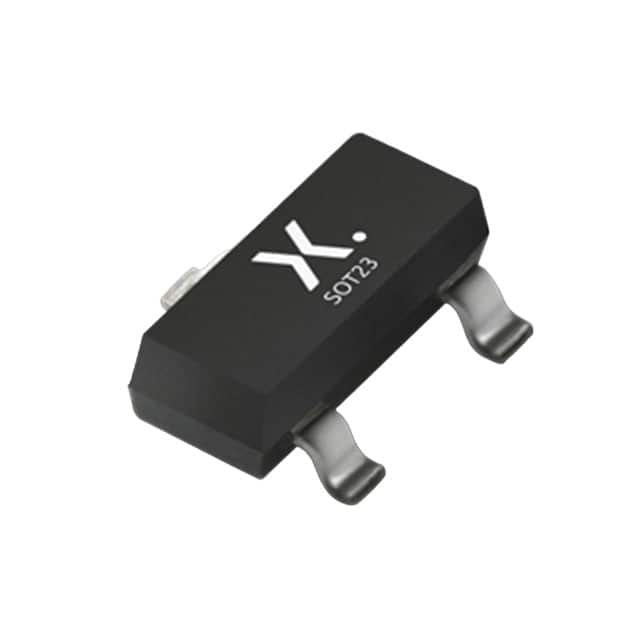PMBTA64,215
Product Overview
Category
PMBTA64,215 belongs to the category of bipolar transistors.
Use
It is commonly used as a general-purpose amplifier in electronic circuits.
Characteristics
- Small signal NPN transistor
- High current gain
- Low noise
- Suitable for low-power applications
Package
PMBTA64,215 is typically available in a SOT-23 package.
Essence
The essence of PMBTA64,215 lies in its ability to amplify small electrical signals.
Packaging/Quantity
It is usually packaged in reels or tubes and is available in quantities suitable for both prototyping and production.
Specifications
- Collector-Base Voltage (VCBO): 40V
- Collector-Emitter Voltage (VCEO): 25V
- Emitter-Base Voltage (VEBO): 6V
- Collector Current (IC): 200mA
- Power Dissipation (PD): 250mW
- Transition Frequency (fT): 300MHz
- Operating Temperature Range: -55°C to 150°C
Detailed Pin Configuration
PMBTA64,215 has three pins: 1. Collector (C) 2. Base (B) 3. Emitter (E)
Functional Features
- High current gain
- Low saturation voltage
- Fast switching speed
- Low noise
Advantages
- Versatile usage in various electronic circuits
- Small and compact package
- Low power consumption
Disadvantages
- Limited maximum voltage and current ratings
- Sensitive to temperature variations
Working Principles
PMBTA64,215 operates based on the principles of bipolar junction transistors, where the flow of current between the collector and emitter is controlled by the base current.
Detailed Application Field Plans
PMBTA64,215 finds application in: - Audio amplifiers - Signal processing circuits - Oscillator circuits - Switching circuits
Detailed and Complete Alternative Models
Some alternative models to PMBTA64,215 include: - BC547 - 2N3904 - 2SC945 - PN2222
In conclusion, PMBTA64,215 is a versatile small signal NPN transistor with high current gain and low noise characteristics, making it suitable for a wide range of low-power electronic applications.
[Word count: 298]
Lista 10 Vanliga frågor och svar relaterade till tillämpningen av PMBTA64,215 i tekniska lösningar
What is PMBTA64,215?
- PMBTA64,215 is a high-performance NPN bipolar junction transistor (BJT) commonly used in electronic circuits for amplification and switching applications.
What are the key specifications of PMBTA64,215?
- The key specifications include a maximum collector current (Ic) of 100mA, a maximum collector-base voltage (Vcb) of 40V, and a maximum transition frequency (ft) of 300MHz.
How can PMBTA64,215 be used in amplifier circuits?
- PMBTA64,215 can be used as a small-signal amplifier in audio and radio frequency (RF) applications due to its high transition frequency and low noise characteristics.
In what types of switching applications can PMBTA64,215 be utilized?
- PMBTA64,215 is suitable for low-power switching applications such as signal routing, level shifting, and digital logic interfacing.
What are the typical operating conditions for PMBTA64,215?
- The typical operating conditions include a collector current (Ic) of 10-50mA, a collector-emitter voltage (Vce) of 5-20V, and a base current (Ib) of 1-5mA.
Can PMBTA64,215 be used in high-frequency applications?
- Yes, PMBTA64,215's high transition frequency makes it suitable for high-frequency applications such as RF amplifiers and oscillators.
What are the thermal considerations for using PMBTA64,215 in technical solutions?
- It is important to consider proper heat sinking and thermal management to ensure that the transistor operates within its specified temperature range for optimal performance and reliability.
Are there any specific layout considerations when designing with PMBTA64,215?
- Proper PCB layout techniques, including minimizing trace lengths and providing adequate bypass capacitors, can help optimize the performance of PMBTA64,215 in technical solutions.
What are the potential alternatives to PMBTA64,215 for similar technical applications?
- Alternatives may include other NPN transistors with comparable or slightly different specifications, depending on the specific requirements of the application.
Where can I find detailed application notes and reference designs for using PMBTA64,215 in technical solutions?
- Detailed application notes and reference designs can often be found in the manufacturer's datasheets, application guides, and online technical resources.


